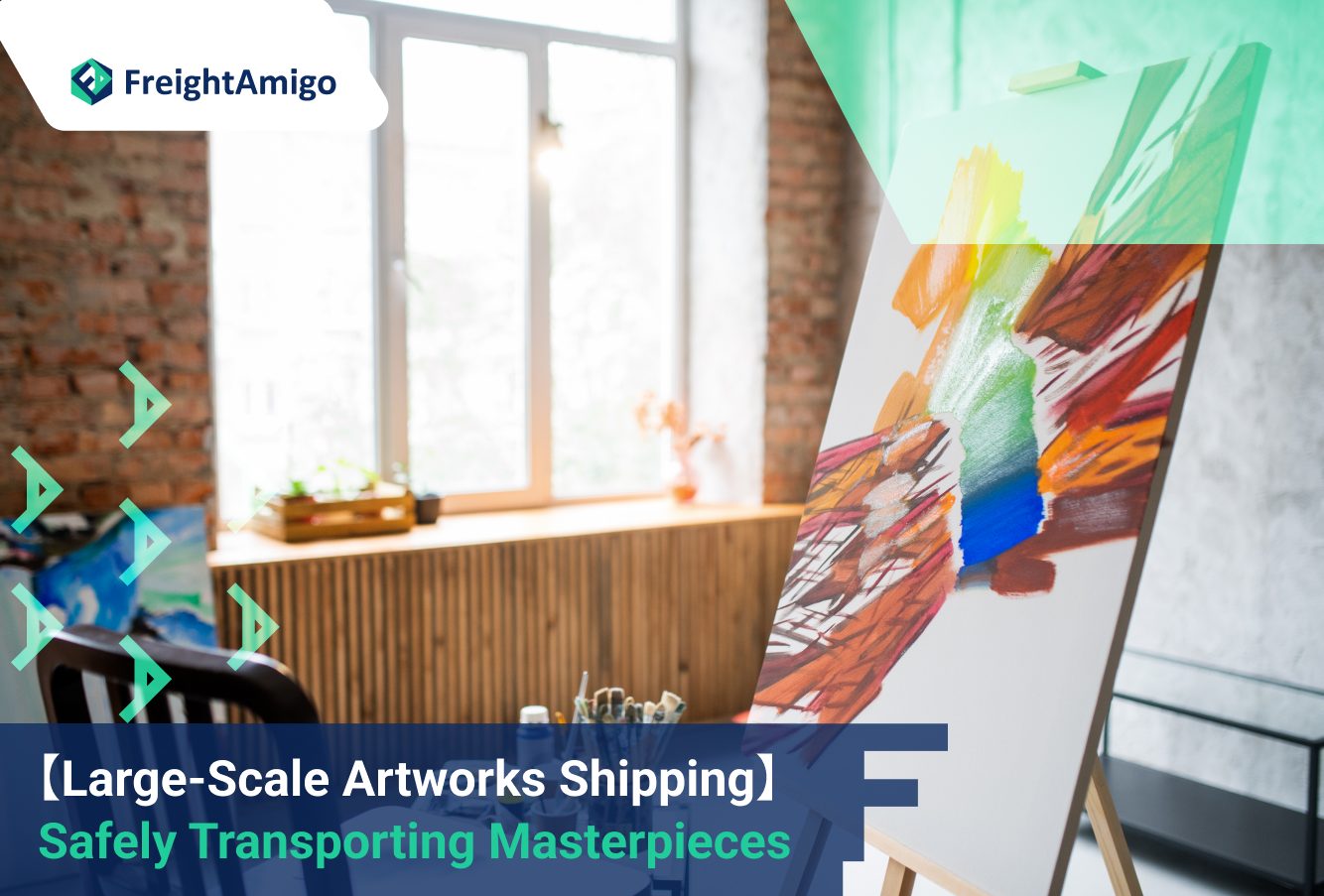Author Name: Tiffany Lee – Marketing Analyst at FreightAmigo
Shipping large-scale artworks, including sculptures, installations, and oversized paintings, requires careful planning, specialized equipment, and expert handling. Whether you are a gallery owner, collector, or artist, ensuring the safe transportation of these valuable and delicate pieces is of utmost importance. In this comprehensive guide, we will explore the unique challenges and considerations involved in shipping large-scale artworks and provide insights into the specialized techniques and equipment required for their safe transportation.
Want To Compare The Best Express, Air Freight, Sea Freight, Rail Freight & Trucking Rates So As To Have Better Control On Cost?
The Importance of Proper Art Transportation
Transporting large-scale artworks is a meticulous process that requires attention to detail and careful handling. These artworks are often one-of-a-kind masterpieces that hold significant value, both monetarily and culturally. Therefore, it is crucial to ensure their safe transportation to protect them from damage or loss. Improper transportation can result in irreversible damage, compromising the integrity and value of the artwork.
Art transportation involves various risks, including breakages, tears, missing elements, impacts, smudges, and exposure to harmful elements such as fingerprints, smoke, chemicals, and light. Additionally, the unpredictable factor of human handling can further increase the risks. To minimize these risks, it is essential to follow proper packing, handling, and transportation procedures.
Packing Large-Scale Paintings
When it comes to transporting large-scale paintings, proper packing is vital to protect the artwork from damage during transit. Here are some guidelines for packing large-scale paintings:
- Choose the right-sized box: Select a box that is slightly larger than the painting itself. This ensures a snug fit and minimizes movement within the box. Avoid using boxes that are too large or too small, as they can increase the risk of damage.
- Protect the artwork: Wrap the front of the painting with several layers of plastic wrap, palette wrap, or any other suitable wrapping material. This provides an additional layer of protection against impacts and ensures the artwork remains secure during transportation.
- Use brown packing paper: Cut two equally sized pieces of brown packing paper, larger than the painting. Place the framed painting face down against one sheet of brown paper, then cover it with the second sheet of brown paper. Tape down the ends of the brown paper together, creating a protective wrapping for the painting. Wrap packing tape around the painting on all sides to ensure the paper remains in place.
- Place the painting in a box: Carefully place the wrapped painting in the appropriately sized box. Add a layer of wrapping paper or shock-absorbent material to provide extra cushioning. Seal the box with wide, firm packing tape, ensuring it is securely closed.
Remember to label the box as fragile and handle it with care during transportation to minimize the risk of damage.
Crating Sculptures and Installations
Transporting sculptures and installations requires specialized crating to ensure their safety and stability. Here are the steps involved in crating large-scale artworks:
- Custom-built crates: Each sculpture or installation should have a custom-built crate designed specifically for its shape, size, and weight. These crates provide maximum protection and stability during transportation.
- Secure packing: The artwork should be securely packed within the crate to prevent movement and potential damage. This may involve using foam padding, strapping, or other appropriate materials to immobilize the artwork.
- Consider the artwork’s fragility: Fragile sculptures or installations may require additional protective measures, such as foam inserts or custom-made supports. These elements help absorb shocks and vibrations during transportation, minimizing the risk of damage.
- Label the crate: Clearly label the crate with appropriate handling instructions, such as “fragile” or “this side up.” This ensures that handlers are aware of the artwork’s delicate nature and handle it with care.
By following these crating guidelines, you can ensure the safe transportation of sculptures and installations, minimizing the risk of damage.
Specialized Transportation Equipment and Techniques
Transporting large-scale artworks often requires specialized equipment and techniques to ensure their safe and secure delivery. Here are some key considerations for transportation:
- Fleet of specialized vehicles: Art transportation companies have custom-designed vehicles equipped with features like climate control, GPS tracking, and air-ride suspension systems. These vehicles ensure optimal conditions for transporting delicate artworks, protecting them from temperature fluctuations, vibrations, and other potential hazards.
- Rigging and handling: Large sculptures or installations may require rigging and specialized handling techniques. Art handlers with expertise in rigging can safely load, secure, and unload these artworks using cranes, forklifts, or other specialized equipment. This ensures the artwork remains stable and protected throughout the transportation process.
- Secure packaging: Art transportation companies use high-quality packing materials, including custom crates, foam padding, and shock-absorbent materials, to provide maximum protection during transit. These packaging materials are designed to withstand the rigors of transportation and minimize the risk of damage.
- Tracking and monitoring: Many art transportation companies offer tracking and monitoring services, allowing you to keep tabs on the location and condition of your artwork during transit. This provides peace of mind and enables you to address any potential issues promptly.
By leveraging specialized transportation equipment and techniques, you can ensure the safe and secure transportation of large-scale artworks, mitigating the risks associated with their transit.
The Benefits of Professional Art Transportation Services
While it may be tempting to handle the transportation of large-scale artworks independently, there are several benefits to hiring professional art transportation services. Here’s why you should consider entrusting the transportation of your valuable artworks to experts:
- Expertise and experience: Professional art transportation companies have extensive experience in handling and transporting delicate and valuable artworks. Their expertise ensures that your artworks are in safe hands throughout the transportation process.
- Specialized equipment and materials: Art transportation companies have access to specialized equipment and materials designed specifically for the transportation of artworks. This ensures that your artworks are packed, loaded, and transported using the most suitable and secure methods.
- Risk reduction: Professional art transportation services minimize the risks associated with handling and transporting artworks. Their trained staff follows industry best practices to ensure the safety and security of your valuable pieces, reducing the chances of damage or loss.
- Insurance coverage: Reputable art transportation companies typically offer insurance coverage for the artworks they transport. This provides an added layer of protection and peace of mind, knowing that you are financially safeguarded in the unlikely event of damage or loss.
- Time and convenience: By entrusting the transportation of your artworks to professionals, you can save time and focus on other aspects of your art business or collection. Professional art transportation services handle all the logistics, allowing you to enjoy a hassle-free experience.
Conclusion
In conclusion, shipping large-scale artworks requires meticulous planning, expert handling, and specialized equipment. By following proper packing techniques, utilizing custom-built crates, and leveraging professional art transportation services, you can ensure the safe transportation of your valuable artworks. Protecting these masterpieces during transit is crucial to maintaining their integrity and value, and entrusting the task to experts will provide peace of mind and convenience.
If you’re planning to transport large-scale artworks, consider partnering with a trusted art transportation company that specializes in handling and transporting delicate and valuable artworks. Their expertise, experience, and commitment to excellence will ensure the safe and secure transportation of your precious pieces, allowing you to focus on what matters most – the beauty and significance of your artwork.
Contact us today to learn more about our specialized art transportation services and how we can assist you in safely shipping your large-scale artworks.
There Are Different Options For Cargo Transportation. If You Want To Choose The Most Convenient And Suitable Solution, It Is Best To Have The Full Support Of Logistics Experts! If You Are Planning To Ship Goods Overseas, Please Go To The FreightAmigo Page For Inquiries.
===
Read More:
【Cosmetic Product Recycling】 A Guide to Sustainable Reverse Logistics
【Rise of Green Supply Chain】 Pioneering Sustainable Practices in Logistics
【ESG in Logistics】 How ESG Practices Drive Social Responsibility in Logistics
===
If you have any inquiries on logistics/supply chain, feel free to contact FreightAmigo now:
Chat with us online OR
Phone : +852 28121686
WhatsApp: +852 27467829









































